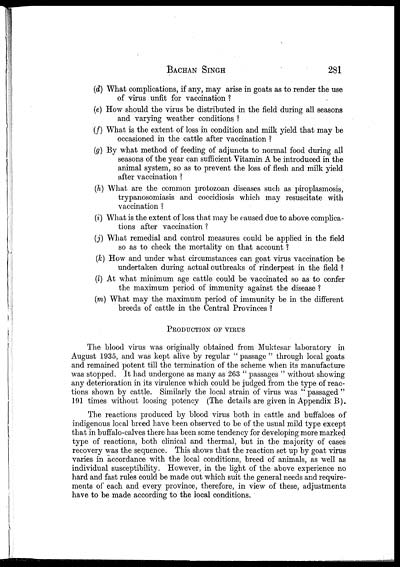Medicine - Veterinary > Veterinary colleges and laboratories > Indian journal of veterinary science and animal husbandry > Volume 9, 1939 > Original articles > Goat virus vaccination in the Central Provinces and Berar (final report)
(183) Page 281
Download files
Individual page:
Thumbnail gallery: Grid view | List view

BACHAN SINGH 281
(d) What complications, if any, may arise in goats as to render the use
of virus unfit for vaccination ?
(e) How should the virus be distributed in the field during all seasons
and varying weather conditions ?
(f) What is the extent of loss in condition and milk yield that may be
occasioned in the cattle after vaccination ?
(g) By what method of feeding of adjuncts to normal food during all
seasons of the year can sufficient Vitamin A be introduced in the
animal system, so as to prevent the loss of flesh and milk yield
after vaccination ?
(h) What are the common protozoan diseases such as piroplasmosis,
trypanosomiasis and coccidiosis which may resuscitate with
vaccination ?
(i) What is the extent of loss that may be caused due to above complica-
tions after vaccination ?
(j) What remedial and control measures could be applied in the field
so as to check the mortality on that account ?
(k) How and under what circumstances can goat virus vaccination be
undertaken during actual outbreaks of rinderpest in the field ?
(l) At what minimum age cattle could be vaccinated so as to confer
the maximum period of immunity against the disease ?
(m) What may the maximum period of immunity be in the different
breeds of cattle in the Central Provinces ?
PRODUCTION OF VIRUS
The blood virus was originally obtained from Muktesar laboratory in
August 1935, and was kept alive by regular " passage " through local goats
and remained potent till the termination of the scheme when its manufacture
was stopped. It had undergone as many as 263 " passages " without showing
any deterioration in its virulence which could be judged from the type of reac-
tions shown by cattle. Similarly the local strain of virus was " passaged "
191 times without loosing potency (The details are given in Appendix B).
The reactions produced by blood virus both in cattle and buffaloes of
indigenous local breed have been observed to be of the usual mild type except
that in buffalo-calves there has been some tendency for developing more marked
type of reactions, both clinical and thermal, but in the majority of cases
recovery was the sequence. This shows that the reaction set up by goat virus
varies in accordance with the local conditions, breed of animals, as well as
individual susceptibility. However, in the light of the above experience no
hard and fast rules could be made out which suit the general needs and require-
ments of each and every province, therefore, in view of these, adjustments
have to be made according to the local conditions.
Set display mode to: Large image | Zoom image | Transcription
Images and transcriptions on this page, including medium image downloads, may be used under the Creative Commons Attribution 4.0 International Licence unless otherwise stated. ![]()
| Permanent URL | https://digital.nls.uk/75246985 |
|---|
| Description | Covers articles from 1939. Please note that pagination starts at p.139 and plates at Plate V. |
|---|




